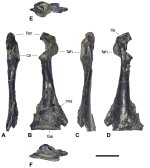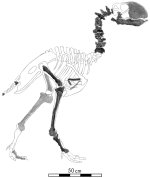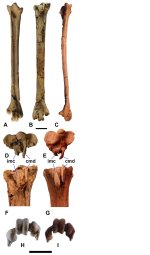Systematic palaeontology
Class Aves Linnaeus, 1758
Cf. Order Galliformes Temminck, 1820
Family Incertae Sedis
Genus Tegulavis nov.
LSID of new genus: 3EDA11B9-F0FE-4CB7-808A-FDB45019D3D0.
Derivation of the name: From tegula, Latin name of tiles that are produced with the clay excavated in the La Borie quarry, and avis, bird.
Type and only species: Tegulavis corbalani nov.gen., nov. sp.
Stratigraphic and geographic occurrence: Ypresian (early Eocene), southern France.
Diagnosis: As for the type species Tegulavis corbalani, by monotypy.
Tegulavis corbalani nov. gen., nov. sp.
LSID of new species: FCFD63DE-EB0B-40AE-9078-7D7ADA3F275B
Derivation of the name: This species is dedicated to Daniel Corbalan, who discovered this coracoideum, in recognition of his work during the excavations of the fossiliferous layers.
Holotype: MHNT.PAL.2021.12.13, right coracoideum.
Type locality: La Borie, Saint-Papoul, Department of Aude, southern France.
Type horizon: Middle Ypresian, early Eocene, reference-level MP 8-9, age ca. 53-52 Ma
(Danilo et al., 2013).
Differential diagnosis: the main characteristics of the Tegulavis coracoideum are as follows: very deep, subcircular cotyla scapularis; facies articularis humeralis strongly projecting laterally; absence of processus procoracoideus and foramen nervi supracoracoidei. These features also occur in the stem group galliforms Quercymegapodiidae, Gallinuloididae and Paraortygidae. However, Tegulavis differs from these taxa mainly in the morphology of the sternal end: both sides of sternal end symmetrical, facies articularis sternalis almost rectilinear, absence of pneumatic foramen and lineae intermusculares on the dorsal surface, presence of wide and rounded keel on the ventral surface. In contrast, in the other families, the sternal end is wider laterally, the facies articularis sternalis is curved, and the ventral surface is flat.
Order Gastornithiformes Stejneger, 1885
Family Gastornithidae Fürbringer, 1888
Genus Gastornis Hébert, 1855
Gastornis laurenti Mourer-Chauviré and Bourdon, 2020
Referred material: see Appendix A. The reconstructed skeleton shows the bones that have been discovered in La Borie.
Order Gruiformes (Bonaparte, 1854)
Cf. Family Aramidae Bonaparte, 1849
Genus Papulavis nov.
LSID of new genus: 0807A8A1-00BF-457F-A28F-CAD8014F2A09.
Derivation of the name: from Papulus, hermit and martyr who lived during the Vth or VIth century and gave his name to the locality of Saint-Papoul, and avis, bird.
Type and only species: Papulavis annae nov. gen., nov. sp.
Stratigraphic and geographic range: Ypresian (early Eocene), southern France
Diagnosis: As for the species Papulavis annae, by monotypy.
Papulavis annae nov. gen., nov. sp.
LSID of new species: AA72688D-B952-48C9-8AB7-2761C38A2098.
Derivation of the name: This species is dedicated to Anne Hauradou, who actively participated in the fieldworks in the fossiliferous locality of La Borie.
Holotype: MHNT.PAL.2021.12.14, almost complete left tarsometatarsus.
Type locality: La Borie, Saint-Papoul, Department of Aude, Southern France.
Type horizon: Middle Ypresian, early Eocene, close to reference-level MP 8-9. Unlike remains of Gastornis, which have been found in the lenticular deposits SP1, SP2 and SP5, this fossil comes from the level SPO, located at the top of the quarry and corresponding to a sandy channel.
Differential diagnosis: Tarsometatarsus elongate, but stouter than in other Gruoidea; cotyla medialis more proximal than cotyla lateralis; eminentia intercotylaris prominent and rounded; hypotarsus showing the configuration of ridges, canals and furrows typical of Aramidae and distinct from extant Psophiidae and Gruidae; relative length of trochleae closer to Aramidae and Gruidae; tr. met. IV more strongly projected plantarly than in Psophiidae, and less so than in Gruidae; differs from recent Aramidae in the size and position of the foramen vasculare distale, this foramen being smaller and located further away from the incisura intertrochlearis lateralis than in Aramus.
cf. Messelornithidae or cf. Walbeckornis
Material: Almost complete left tibiotarsus, MHNT.PAL.2021.12.15.
Aves incertae sedis
Material: almost complete right clavicula, MHNT.PAL.2018.17.1 (Fig. 11(B)); omal part of left clavicula, MHNT.PAL.2018.17.2.
Fred
Fig. 1. Tegulavis corbalani nov. gen., nov. sp. from La Borie (early Eocene; Southern France), right coracoideum MHNT.PAL.2021.12.13 (holotype) in medial (A), dorsal (B), lateral (C), ventral (D), omal (E), and sternal (F) views. Abbreviations: cs, cotyla scapularis; fac, facies articularis clavicularis; fah, facies articularis humeralis; fas, facies articularis sternalis; ila, impressio lig. acrocoracohumeralis; ims, impressio m. sternocoracoidei. Scale bar: 1 cm.
Fig. 2. Reconstructed skeleton of Gastornis laurenti Mourer-Chauviré and Bourdon, 2020. The right femur and tibiotarsus are thin because they have been strongly compressed craniocaudally.
Fig. 3. A-D, F, H. Papulavis annae nov.gen., nov. sp. from La Borie (early Eocene; Southern France), left tarsometatarsus MHNT.PAL.2021.12.14 (holotype) in dorsal (A), plantar (B), medial (C), proximal (D) views, plantar view of the hypotarsus (F) and distal view (H). E, G, I. Recent species Aramus guarauna MNHN 554 339, left tarsometatarsus in proximal view (E), plantar view of the hypotarsus (G), and distal view (I). Abbreviations: cmd, crista medialis hypotarsi; imc, crista intermedia hypotarsi. Scale bars: 1 cm.







